2023 Honda Odyssey Engine Oil and Fluids
The complex gears of the 2023 Honda Odyssey show how important it is to keep track of the engine oil and other fluids. This is a key part of the vehicle’s performance and durability. The Odyssey works like a well-balanced symphony, with each important fluid playing a key role in making sure the vehicle works well and runs smoothly. Engine oil, which is like the vehicle’s blood, lubricates the complex parts of the engine, lowering friction and getting rid of heat to keep the car running well. It’s very important to use the right type and thickness of oil, and changing it at the recommended times keeps the engine healthy. Transmission oil makes it easy to change gears, and coolant keeps the engine at the right temperature. Brake fluid and power steering fluid help you stop quickly and steer easily, which is very important for safety and driving pleasure. Drivers can keep an eye on their vehicle’s vital signs by checking the fluid levels regularly. Reservoirs and dipsticks make it easy to do this. The Odyssey’s performance, safety, and reliability are kept up by sticking to the right levels and planned replacements. In essence, the engine oil and other fluids in the 2023 Honda Odyssey show how well-engineered the car is. As these important parts move through the car’s complex systems, they show how committed Honda is to making sure that every trip is smooth, efficient, and based on reliability.
Recommended Engine Oil
- Honda Genuine Motor Oil
- Premium-grade 0W-20 detergent oil with an API Certification Seal on the container.
Engine Oil Additives
Your vehicle does not require oil additives. In fact, they may adversely affect the engine performance and durability.
 Oil is a major contributor to your engine’s performance and longevity. If you drive the vehicle with insufficient or deteriorated oil, the engine may fail or be damaged.
Oil is a major contributor to your engine’s performance and longevity. If you drive the vehicle with insufficient or deteriorated oil, the engine may fail or be damaged.
This seal indicates the oil is energy conserving and that it meets the American Petroleum Institute’s latest requirements.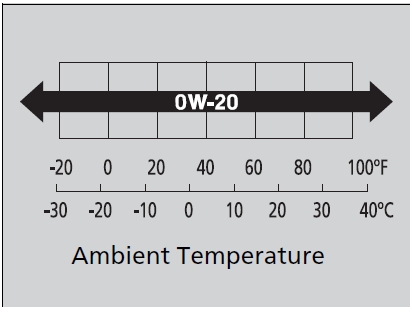 Use Honda Genuine Motor Oil or another commercial engine oil of suitable viscosity for the ambient temperature as shown.
Use Honda Genuine Motor Oil or another commercial engine oil of suitable viscosity for the ambient temperature as shown.
Synthetic oil
You may also use synthetic motor oil if it is labeled with the API Certification Seal and is the specified viscosity grade.
Oil Check
We recommend that you check the engine oil level every time you refuel.
Park the vehicle on level ground.
Wait approximately three minutes after turning the engine off before you check the oil.
- Remove the dipstick (orange).
- Wipe the dipstick with a clean cloth or paper towel.
- Insert the dipstick back all the way into its hole.
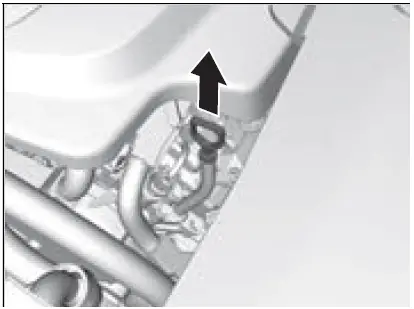
- Remove the dipstick again, and check the level. It should be between the upper and lower marks. Add oil if necessary.
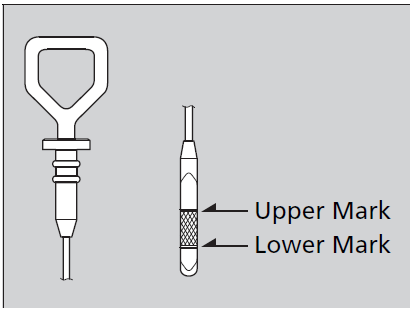
If the oil level is near or below the lower mark, slowly add oil, being careful not to overfill.
Adding Engine Oil
- Unscrew and remove the engine oil fill cap.
- Add oil slowly.
- Reinstall the engine oil fill cap, and tighten it securely.
- Wait for three minutes and recheck the engine oil dipstick.
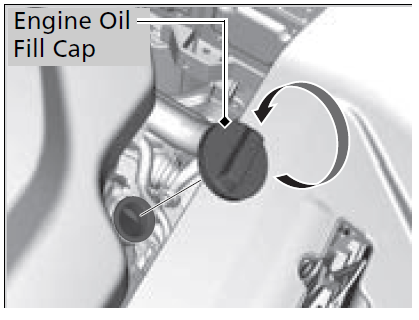 NOTICE
NOTICE
Do not fill the engine oil above the upper mark. Overfilling the engine oil may result in leaks and engine damage.
If any oil spills, wipe it away immediately. Spilled oil may damage the engine compartment components.
Changing the Engine Oil and Oil Filter
You must change the engine oil and oil filter regularly in order to maintain the engine’s lubrication. The engine may be damaged if they are not changed regularly.
Change the oil and filter in accordance with the maintenance message on the driver information interface.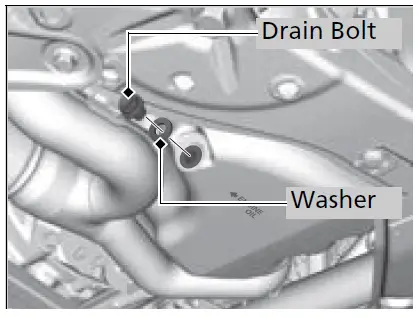
- Run the engine until it reaches normal operating temperature, and then turn the engine off.
- Open the hood and remove the engine oil fill cap.
- Remove the drain bolt and washer from the bottom of the engine, and drain the oil into a suitable container.
NOTICE
You may damage the environment if you do not dispose of the oil in a suitable way. If you are changing the oil by yourself, appropriately dispose of the used oil. Put the oil in a sealed container and take it to a recycling center. Do not throw the oil away into a garbage can or onto the ground. - Remove the oil filter and dispose of the remaining oil.
- Check that the filter gasket is not stuck to the engine contact surface.
- If it is stuck, you must detach it.
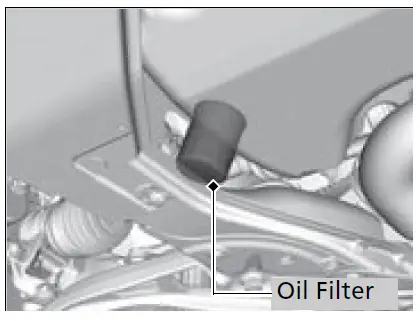
- If it is stuck, you must detach it.
- Wipe away dirt and dust adhering to the contact surface of the engine block, and install a new oil filter.
- Apply a light coat of new engine oil to the filter gasket.
- Put a new washer on the drain bolt, then reinstall the drain bolt.
- Tightening torque: 29 lbf∙ft (40 N∙m, 4.0 kgf∙m)
- Pour the recommended engine oil into the engine.
- Engine oil change capacity (including filter): 5.7 US qt (5.4 L)
- Reinstall the engine oil fill cap securely and start the engine.
- Run the engine for a few minutes, and then check that there is no leak from the drain bolt or oil filter.
- Stop the engine, wait for three minutes, and then check the oil level on the dipstick.
- If necessary, add more engine oil.
You will need a special wrench to replace the oil filter. You can buy this wrench from a dealer.
When installing the new oil filter, follow the instructions supplied with the oil filter.
Reinstall the engine oil fill cap. Start the engine. If the low oil pressure warning appears, turn off the engine, and check your work.
Engine Coolant
Specified coolant: Honda Long Life Antifreeze/Coolant Type 2
This coolant is premixed with 50% antifreeze and 50% water. Do not add any straight antifreeze or water.
We recommend you check the engine coolant level every time you refuel. Check the reserve tank first. If it is completely empty, also check the coolant level in the radiator. Add the engine coolant accordingly.
WARNING
Removing the radiator cap while the engine is hot can cause the coolant to spray out, seriously scalding you.
Always let the engine and radiator cool down before removing the radiator cap.
Reserve Tank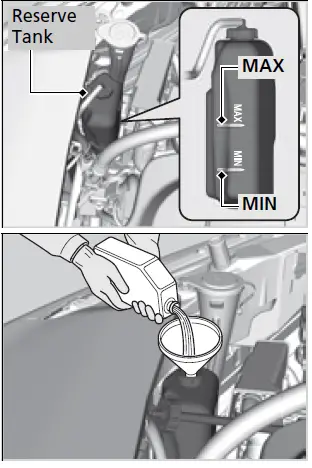
- Make sure the engine and radiator are cool.
- Check the amount of coolant in the reserve tank.
- If the coolant level is below the MIN mark, add the specified coolant until it reaches the MAX mark.
- Inspect the cooling system for leaks.
NOTICE
Genuine Honda engine coolant is a 50/50 mixture of antifreeze and water that can withstand freezing at temperatures as low as about -31°F (-35°C). If your vehicle is consistently subjected to temperatures
below this, the concentration of antifreeze in the coolant should be increased. Consult a dealer for details.
If Honda antifreeze/coolant is not available, you may use another major brand of non-silicate coolant as a temporary replacement. Check that it is a high quality coolant recommended for aluminum engines. Continued use of any non-Honda coolant can result in corrosion, causing the cooling system to malfunction or fail. Have the cooling system flushed and refilled with Honda antifreeze/coolant as soon as possible.
Do not add rust inhibitors or other additives to your vehicle’s cooling system. They may not be compatible with the coolant or with the engine components.
Radiator
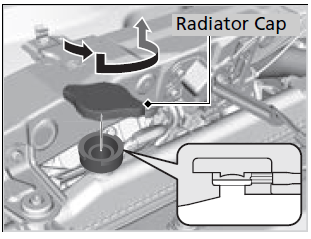
- Make sure the engine and radiator are cool.
- Remove the engine compartment cover.
Engine Compartment Cover - Turn the radiator cap 1/8 turn counter-clockwise and relieve any pressure in the cooling system.
- Push down and turn the radiator cap counter-clockwise to remove it.
- The coolant level should be up to the base of the filler neck. Add coolant if it is low.
- Put the radiator cap back on, and tighten it fully.
NOTICE
Pour the fluid slowly and carefully so you do not spill any. Clean up any spills immediately; they can damage components in the engine compartment.
Transmission Fluid
Automatic Transmission Fluid
Specified fluid: Honda ATF-Type 2
Have a dealer check the fluid level and replace if necessary.
Do not attempt to check or change the automatic transmission fluid yourself.
NOTICE
Honda ATF-Type 2 fluid must not be mixed with other transmission fluids.
Using a transmission fluid other than Honda ATF-Type 2 may adversely affect the operation and durability of your vehicle’s transmission, and damage the transmission.
Any damage caused by using a transmission fluid that is not equivalent to Honda ATF-Type 2 is not covered by Honda’s new vehicle limited warranty.
Brake Fluid
Specified fluid: Honda Heavy Duty Brake Fluid DOT 3
Checking the Brake Fluid
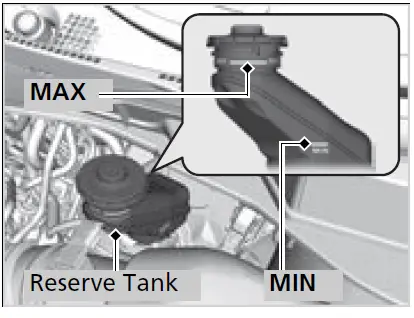 The fluid level should be between the MIN and MAX marks on the side of the reserve tank.
The fluid level should be between the MIN and MAX marks on the side of the reserve tank.
NOTICE
Brake fluid marked DOT 5 is not compatible with your vehicle’s braking system and can cause extensive damage.
If the specified brake fluid is not available, you should use only DOT 3 or DOT 4 fluid from a sealed container as a temporary replacement.
Using any non-Honda brake fluid can cause corrosion and decrease the longevity of the system. Have the brake system flushed and refilled with Honda Heavy Duty Brake Fluid DOT 3 as soon as possible?
If the brake fluid level is at or below the MIN mark, have a dealer inspect the vehicle for leaks or worn brake pads as soon as possible.
Refilling Window Washer Fluid
Check the amount of window washer fluid by looking at the reservoir.
If the level is low, fill the washer reservoir.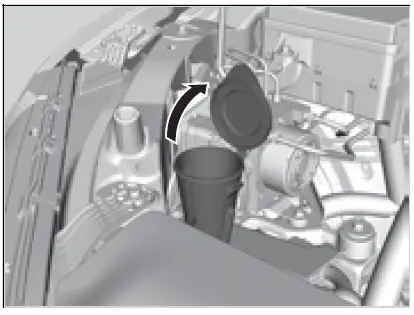
Canadian models
If the washer fluid is low, a message appears on the driver information interface.
Pour the washer fluid carefully. Do not overflow the reservoir.
NOTICE
Do not use engine antifreeze or a vinegar/water solution in the windshield washer reservoir. Antifreeze can damage your vehicle’s paint. A vinegar/water solution can damage the windshield washer pump.
Use only commercially available windshield washer fluid.
Avoid prolonged use of hard water to prevent lime scale buildup.
FAQ
The 2023 Odyssey requires various fluids, including engine oil, coolant, transmission fluid, brake fluid, and power steering fluid.
The recommended engine oil type and viscosity are typically outlined in the vehicle’s owner’s manual. It’s important to use the specified oil for optimal performance.
The recommended oil change interval is usually provided in the owner’s manual, often around every 5,000 to 7,500 miles or as indicated by the maintenance reminder.
Yes, many models of the 2023 Odyssey can use synthetic engine oil for improved performance and extended oil change intervals.
The engine oil level can often be checked using the oil dipstick located under the hood. Refer to the owner’s manual for the correct procedure.
Transmission fluid lubricates and cools the transmission, ensuring smooth shifting and preventing overheating.
The transmission fluid level can often be checked by a professional technician, as it requires specific tools and procedures.
The coolant level can usually be checked through the coolant reservoir under the hood when the engine is cool.
Yes, the recommended coolant type is usually specified in the owner’s manual. Use the recommended coolant to prevent damage.
Brake fluid transmits hydraulic pressure from the brake pedal to the brake components, enabling effective braking.
Brake fluid levels can often be checked in the brake fluid reservoir under the hood. Refer to the owner’s manual for proper procedures.
Yes, the 2023 Odyssey typically has a power steering fluid reservoir that can be checked for proper levels.
If you notice a fluid leak, it’s important to have the vehicle inspected by a professional technician to identify and address the issue.
Yes, many fluids, such as coolant and transmission fluid, should be replaced according to the recommended intervals outlined in the owner’s manual.
It’s important to use the recommended fluids specified in the owner’s manual and avoid mixing different types, as it can affect performance and compatibility.
Useful Link
View Full PDF: Honda Odyssey 2023 |Auto User Guide
2023 Honda Odyssey Customized Feature Guide
2024 Honda Odyssey Specs, Price, Features, Mileage (Brochure)


